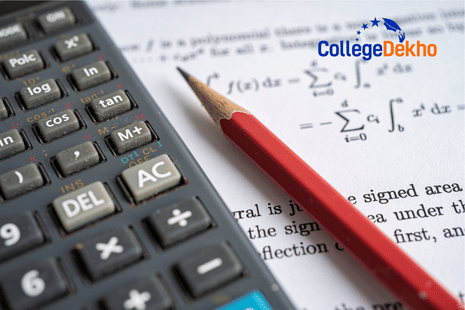
WBJEE 2025 Properties of Matter Practice Questions with Solutions:
Practicing with WBJEE 2025 Properties of Matter sample questions and solutions will help you identify the important topics and sub topics, improve your accuracy when answering the questions, and tackle the exam pressure better. The chapter typically carries moderate weightage and accounts for around 2-3 questions in the exam, translating to approximately 4-6 marks from the Physics section. The 'Properties of Matter' chapter in the
WBJEE 2025 Physics syllabus PDF
covers topics such as Elasticity, Viscosity, and Surface tension. For the
WBJEE 2025 exam
, you can expect questions from sections like Stress and Strain, Young’s Modulus, and Fluid Properties. WBJEE 2025 Properties of Matter practice questions with solutions are based on problem-solving skills and may involve numerical calculations or theory-based reasoning. The difficulty level for this chapter generally ranges from moderate to difficult, depending on the complexity of the questions.
Let us explore some of the most expected and frequently asked WBJEE Properties of Matter sample questions with answer solutions here.
Also Check -
WBJEE 2025 Differential Equations Practice Questions with Solutions
Quick Links:
List of WBJEE 2025 Properties of Matter Sub Topics for Exam Preparation
Before attempting practice questions from WBJEE Properties of Matter chapter you must know of the topics and sub topics listed under it. The Properties of Matter chapter in WBJEE Physics covers several key sub-topics. Find the sub topics and sections here below that are included in the Properties of Matter chapter.Chapter | Sub- opics |
|---|---|
Properties of Matter | Elasticity and Young's modulus |
Viscosity and fluid mechanics | |
Surface tension | |
Thermal properties of matter |
WBJEE 2025 Properties of Matter Expected Weightage
This section includes WBJEE 2025 Properties of Matter expected marks weightage and number of questions in the upcoming exam session. The chapter typically carries moderate weightage and if you study well with WBJEE Properties of Matter practice questions you can score an easy 4-6 marks.Chapter | Average Weightage | Number of Questions | Approximate Marks |
|---|---|---|---|
Properties of Matter | Moderate | 2-3 | 4-6 |
Also Check -
WBJEE 2025 Matrices and Determinants Practice Questions with Solutions
Quick Links:
| Best WBJEE Coaching Institutes in India 2025 | WBJEE Previous Year Question Papers |
|---|---|
| WBJEE Sample Papers | Best Books for WBJEE 2025 Exam Preparation |
WBJEE 2025 Properties of Matter Practice Questions with Solutions
If your aim is to score 40+ marks in WBJEE Physics and improve your overall exam score, then studying the WBJEE 2025 syllabus PDF alone will not suffice. Once you have learnt the fundamental concepts, we suggest you to go through the previous years' papers and attempt WBJEE 2025 Properties of Matter practice questions regularly to track your preparation level. In this section we have compiled a series of WBJEE Properties of Matter sample questions based on the year-wise paper analysis that will help you figure out the expected topics in the upcoming exam session.Q1. What force is required to stretch a steel wire 1 cm2 in cross section to increase its length by 1% given [Y=2×1011 N/m2]?
(a) 2×10 7 N
(b) 2×10 6 N
(c) 2×10 5 N
(d) 4×10 11 N
Answer: (c) 2×10 5 N
Solution:
A=1 cm 2
Δl/l=0.01
Y=2×10 11 N/m 2
To find: Force
F/A=YxΔl/l
⇒F=AYΔl/l
⇒F=(1×10 −4 )×2×10 11 ×10 −2
⇒F=2×10 5 N
Hence Answer→(C)
Q2. Poise is a unit of:(a) Density
(b) Viscosity
(c) Surface tension
(d) Pressure
Answer: (b) Viscosity
Explanation: Poise is the CGS unit of viscosity.
Q3. Combustibility is a:(a) Physical property
(b) Reactive Property
(c) Chemical Property
(d) Not a property
Answer: (c) Chemical property
Explanation: A chemical change is required for the measurement or observation of chemical properties. Physical qualities can be measured without a chemical change occurring. Chemical characteristics include acidity or basicity, combustibility etc.
Q4. Which of the following is correct when given a coffee and water solution, as well as water and pepper?(a) Pepper has the same solubility as coffee when stirred.
(b) Pepper is water soluble, while coffee is not.
(c) While coffee dissolves in water, pepper does not.
(d) The solubility of coffee and pepper is the same.
Answer: (c) While coffee dissolves in water, pepper does not .
Explanation:
Salt, sugar, and coffee all dissolve in water. In hot water, they usually dissolve faster and better. Pepper and sand are insoluble, meaning they won’t dissolve even in boiling water.
Q5. A form of matter has no fixed shape and no fixed volume. An example of this form of matter is:
(a) Petrol
(b) Iron
(c) Krypton
(d) Carbon steel
Answer: (c) Krypton
Explanation: Gases have neither a fixed volume nor a fixed shape. They take up the entire volume of the container in which they are placed. Krypton is a kind of gas. Petrol is a liquid. Solids are iron and steel.
Q6. In a material, stress directly proportional to strain occurs under:
(a) Plastic deformation
(b) Elastic limit
(c) Fracture point
(d) None of these
Answer: (b) Elastic limit
Explanation: Stress and strain are proportional within the elastic limit.
Q7. Which property allows a liquid to rise in a thin capillary tube?
(a) Viscosity
(b) Density
(c) Surface tension
(d) Elasticity
Answer: (c) Surface tension
Explanation: Surface tension enables capillary action.
Q8. A material shows a large strain for a small applied stress. It is:
(a) Ductile
(b) Brittle
(c) Elastic
(d) Plastic
Answer: (a) Ductile
Explanation: High strain at low stress indicates ductility.
Q9. The breaking stress for a material is:(a) Constant for all materials
(b) The maximum stress the material can bear
(c) Inversely proportional to strain
(d) Dependent on Young’s modulus only
Answer: (b) The maximum stress the material can bear
Explanation: Breaking stress is the maximum stress a material can withstand.
Q10. A piece of wood is floating in water. When the temperature of water rises, the apparent weight of the wood will:(a) Increase
(b) Decrease
(c) May increase or decrease
(d) Remain the same
Answer: (a) Increase
Solution:
The apparent weight of an object is given by the real weight of the object minus the buoyant force:
W apparent =W real −F buoyant
As the buoyant force decreases with the decrease in water's density, the apparent weight of the wood will increase. This can be verified by the following equation:
ΔW apparent =−ΔF buoyant
Since ΔF buoyant is negative when the density of water decreases, overall, the apparent weight W apparent increases.
Therefore, the correct option is Option A: increase
Year-wise Question Analysis of WBJEE Properties of Matter
Over the years, the Properties of Matter chapter has consistently contributed a significant portion of questions in the WBJEE exam. Let us see here the type of questions asked on a yearly basis from the Properties of Matter chapter.
WBJEE 2024 | WBJEE 2023 | WBJEE 2022 |
|---|---|---|
The trend of challenging questions continued, with a focus on real-world applications. Students encountered problems involving the calculation of elastic constants, analysis of fluid flow in various geometries, and thermal stress in materials. | This year topics like fluid dynamics, including Bernoulli's theorem and Poiseuille's law, were more emphasized. Additionally, questions on thermal expansion and specific heat capacity were also asked. | The exam featured several questions from Young's modulus, coefficient of viscosity, and thermal conductivity. These questions assessed students' understanding of material properties and their practical applications. |
Quick Links:
To gain complete control over the WBJEE Physics Properties of Matter chapter, you should inculcate the habit of taking WBJEE 2025 mock test along with solving practice questions. It will give you a feel of the actual exam paper and environment as well as help improve your time management and accuracy.Related Articles
We hope that this post on the WBJEE 2025 Properties of Matter Practice Questions with Solutions was helpful and informative. For the latest exam updates, stay tuned to CollegeDekho!
















Similar Articles
VITEEE 2025 Syllabus
Low Rank in JEE Main 2025? Check the List of Engineering Colleges
NIT Trichy BTech CSE Cutoff 2025 - College and Course Wise JEE Main Cut Off
List of NITs for JEE Main 2025 Rank 25,000 to 50,000
List of NITs Accepting JEE Main Rank 75,000 to 1,00,000
List of NITs Accepting JEE Main 2025 Rank 50,000 to 75,000